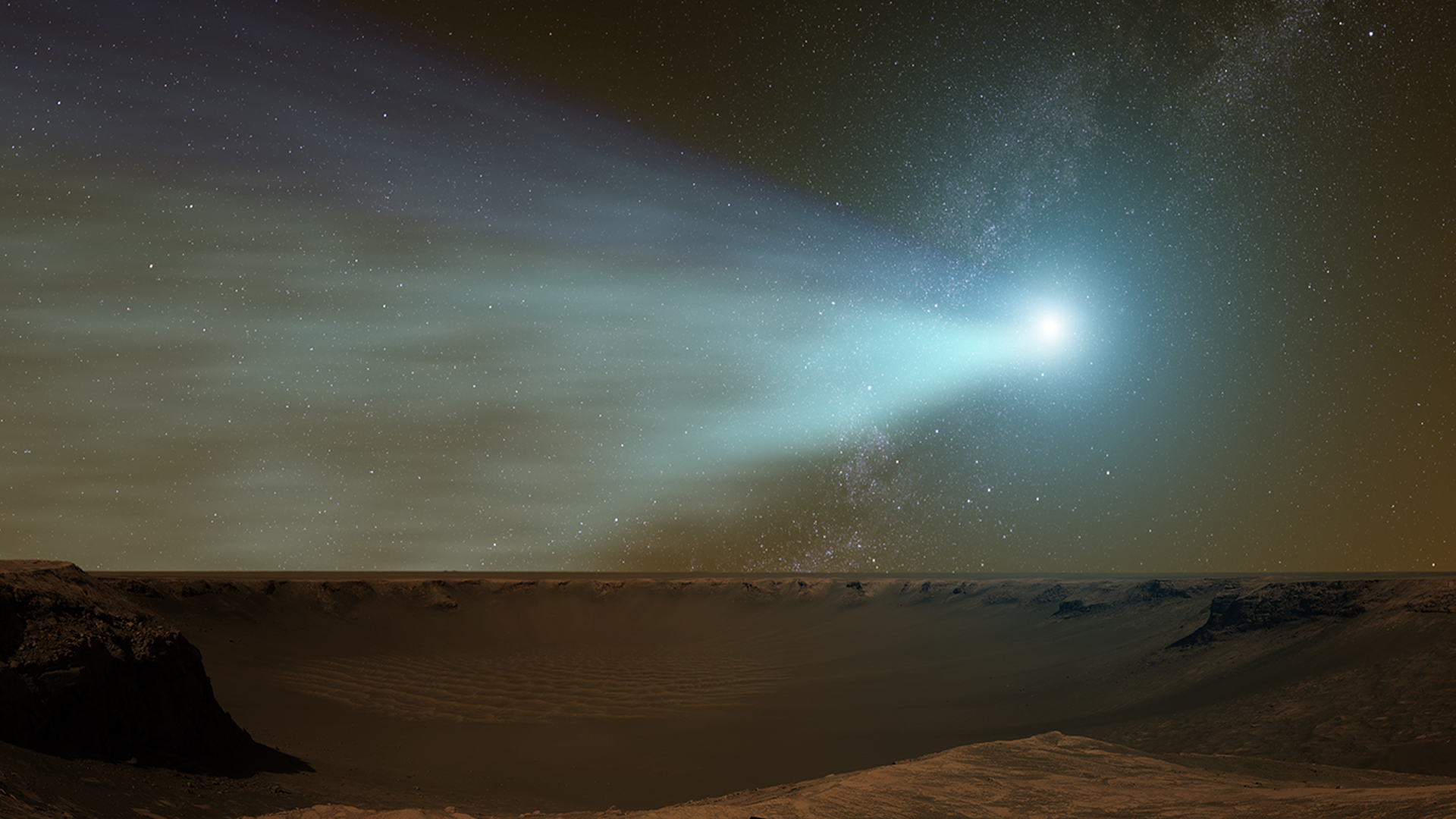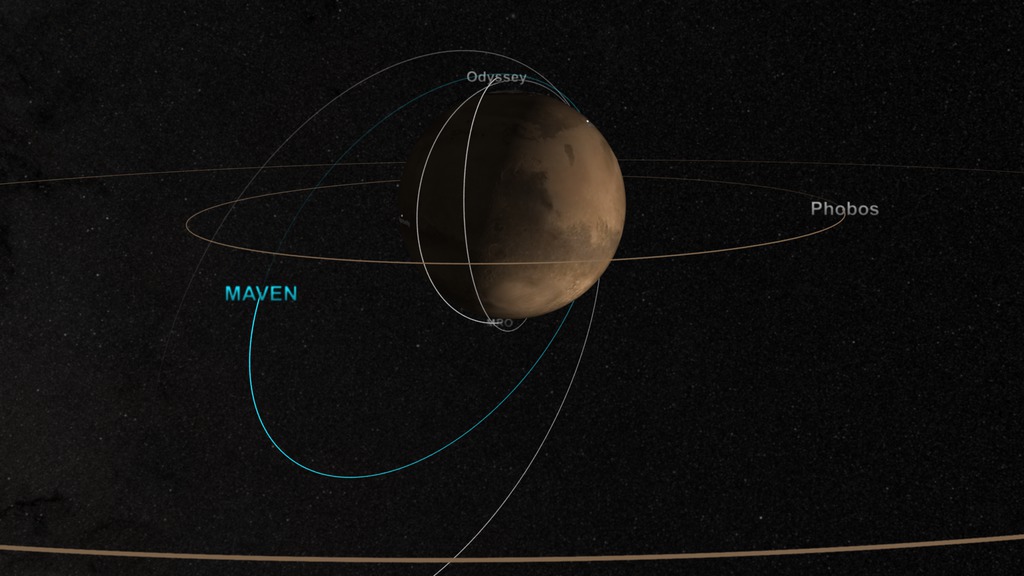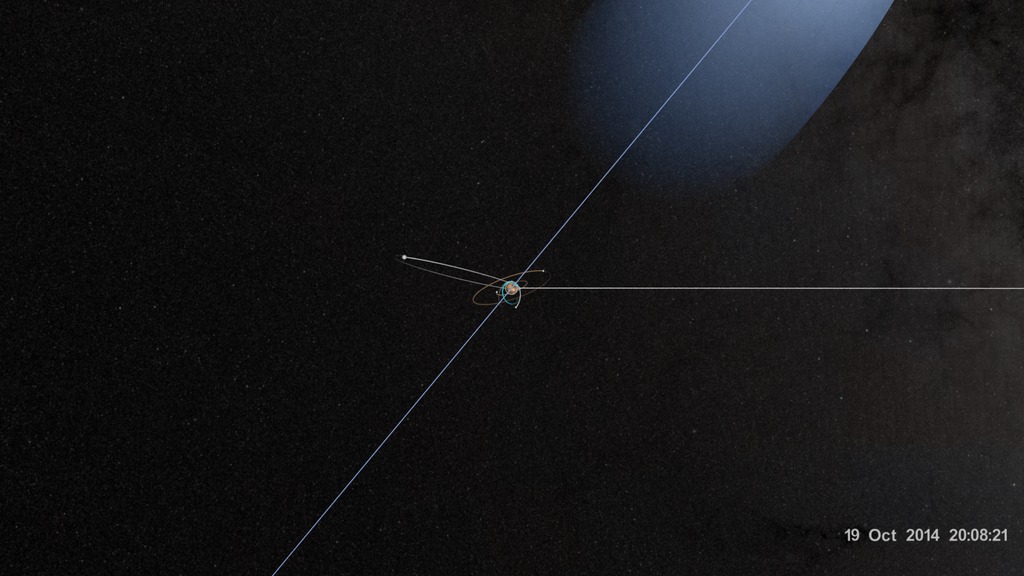Comet Siding Spring
Overview
On October 19, 2014, Comet Siding Spring will make a remarkably close flyby of Mars, coming within one third of the Earth-Moon distance from the Red Planet. NASA will mobilize an entire fleet of rovers, orbiters, Earth observatories and space telescopes to watch the encounter. This gallery contains data visualizations, animations, interviews with NASA scientists, and a narrated video all related to the flyby.
Animations and Data Visualizations
Observing Comet Siding Spring at Mars
Go to this pageOn October 19, 2014, Comet Siding Spring will make a remarkably close encounter with Mars, buzzing the Red Planet at just one third of the Earth-Moon distance. To witness this historic event, NASA has mobilized an entire fleet of rovers, orbiters, Earth observatories and space telescopes.For complete transcript, click here.Watch this video on the NASAexplorer YouTube channel. || Comet_SS_from_Mars.png (1920x1080) [2.4 MB] || Comet_SS_from_Mars_thm.png (80x40) [7.3 KB] || Comet_SS_from_Mars_web.png (320x180) [70.0 KB] || Comet_SS_from_Mars_searchweb.png (320x180) [70.0 KB] || G2014-091_Comet_SS_MASTER_appletv.m4v (960x540) [75.9 MB] || G2014-091_Comet_SS_MASTER_appletv_subtitles.m4v (960x540) [75.9 MB] || G2014-091_Comet_SS_MASTER_appletv.webm (960x540) [20.4 MB] || G2014-091_Comet_SS_MASTER_1280x720.wmv (1280x720) [87.6 MB] || G2014-091_Comet_SS_MASTER_nasaportal.mov (640x360) [74.4 MB] || G2014-091_Comet_SS_MASTER_youtube_hq.en_US.vtt [2.9 KB] || G2014-091_Comet_SS_MASTER_youtube_hq.en_US.srt [2.8 KB] || G2014-091_Comet_SS_MASTER_ipod_lg.m4v (640x360) [30.2 MB] || G2014-091_Comet_SS_MASTER_ipod_sm.mp4 (320x240) [16.3 MB] || G2014-091_Comet_SS_MASTER_H264.mov (1920x1080) [2.4 GB] || G2014-091_Comet_SS_MASTER_prores.mov (1280x720) [2.5 GB] || G2014-091_Comet_SS_MASTER_youtube_hq.mov (1920x1080) [230.1 MB] || G2014-091_Comet_SS_MASTER.mov (1920x1080) [7.6 GB] ||
Comet Siding Spring: Live Shots 2014
Go to this pageB-roll used to support Comet Siding Spring Live shot on Friday, October 17, 2014 || LS_Broll_Pic.png (1682x940) [1.6 MB] || LS_Broll_Pic_print.jpg (1024x572) [94.6 KB] || LS_Broll_Pic_web.jpg (319x178) [16.5 KB] || LS_Broll_Pic_searchweb.png (320x180) [74.1 KB] || LS_Broll_Pic_web.png (320x178) [73.6 KB] || LS_Broll_Pic_thm.png (80x40) [10.7 KB] || Broll_Comet_Siding_Spring_LS.m4v (960x540) [55.3 MB] || Broll_Comet_Siding_Spring_LS_youtube_hq.mov (1280x720) [60.9 MB] || Broll_Comet_Siding_Spring_LS_prores.mov (1280x720) [1.9 GB] || Broll_Comet_Siding_Spring_LS_1280x720.wmv (1280x720) [59.0 MB] || Broll_Comet_Siding_Spring_LS.webm (960x540) [14.0 MB] || Broll_Comet_Siding_Spring_LS.mov (640x360) [49.6 MB] || Broll_Comet_Siding_Spring_LS_720x480.wmv (720x480) [47.7 MB] || Broll_Comet_Siding_Spring_LS.mp4 (320x240) [9.3 MB] ||
Comet Siding Spring and Mars
Go to this pageNASA's MAVEN spacecraft observes Comet Siding Spring during its encounter with Mars. || Comet_Passing_Mars_0072000702_print.jpg (1024x576) [65.5 KB] || Comet_Passing_Mars_00720_print.jpg (1024x576) [78.4 KB] || Comet_Passing_Mars_00720_searchweb.png (320x180) [56.8 KB] || Comet_Passing_Mars_00720_web.png (320x180) [56.8 KB] || Comet_Passing_Mars_00720_thm.png (80x40) [4.2 KB] || Comet_Passing_Mars_FINAL.mov (1920x1080) [1004.7 MB] || Comet_Passing_Mars_h264_FINAL.mov (1920x1080) [34.4 MB] || Comet_Passing_Mars_1080.mp4 (1920x1080) [13.7 MB] || CometPassing (1920x1080) [128.0 KB] || Comet_Passing_Mars_1080.webm (960x540) [2.1 MB] ||
Comet Siding Spring wide shots
Go to this pageThese visualizations show MAVEN and Comet Siding Spring making their way through the solar system to a close encounter near Mars. Two wide angle views are included. The first one maintains a fixed camera above the ecliptic plane of the solar system. The second one moves the camera in a bit closer and more parallel with the ecliptic plane as the comet and MAVEN encounter the Martian region. ||
Mars Fleet and Comet Siding Spring
Go to this pageThis visualization shows NASA’s fleet of Mars orbiters, landers, and rovers during the planet’s close encounter with Comet Siding Spring. C/2013 A1, better known as Comet Siding Spring, will make a remarkably close pass of Mars on October 19, 2014. At closest approach, Comet Siding Spring will come within 82,000 miles of the Red Planet – just one-third of the distance from the Earth to the Moon. During the flyby, NASA will position its Mars fleet both to protect it from comet dust, and to make observations of the comet and its effects on the upper atmosphere of Mars. ||
Sun view of Comet Siding Spring and the Mars orbiting fleet
Go to this pageThis visualization shows active spacecraft orbiting Mars and their relationship to Comet Siding Spring. The comet passes very close to Mars on October 19, 2014. The camera is looking from the direction of the Sun towards Mars. The camera is fixed to Mars and the orbit trail of Mars goes off to the right.As Comet Siding-Spring makes its way through the Martian neighborhood it reaches the closest distance at about 18:32 UT. Debris left by the comet follows behind the comet on the line representing where the comet was. This derbis impacts Mars at about 20:08 UT. Scientists and engineers are concerned that the derbis may harm the spacecraft. Several of the spacecraft have executed orbital maneuvers to put them on the opposite side of Mars when the debris impacts. ||





